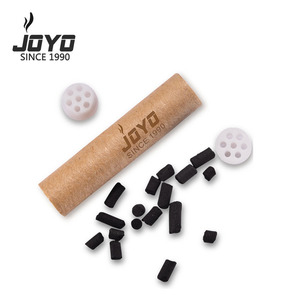(1999 products available)
























































































































































































































A cigarette filter is a significant component of a cigarette. It is the part that smokers put in their mouths. Its primary purpose is to trap harmful substances in cigarette smoke before it reaches the smoker's mouth and lungs. Cigarette filters manufacturers produce different types of filters. Some popular choices are cellulose acetate, paper, activated charcoal, and natural fiber filters. These filters reduce tar and nicotine intake, improve smoking safety, and provide a better smoking experience. Over the years, the design and materials used in making cigarette filters have changed a lot. These changes aim to improve the health impact of smoking by decreasing the harmful substances smokers inhale.
Many cigarette filter manufacturers make designs that are meant to reduce the health risks linked to smoking by filtering out dangerous chemicals in cigarette smoke. Smokers who want to lessen their exposure to harmful substances can use these improved filter designs. The world is becoming more health-conscious, and there is a growing demand for products that have less environmental impact. Cigarette filter producers are responding to this demand by making biodegradable filters. These filters break down naturally over time, unlike traditional ones that can stay in the environment for a long time.
Cigarette filters manufacturers use different types of materials to make filters. Some of the popular ones include:
The design of cigarette filters is crucial for their performance and the smoking experience. Different elements such as length, diameter, and type of material used, as well as the use of additives, greatly affect the filters' ability to reduce tar and nicotine, alter flavor, and provide the desired taste and feel. Manufacturers are continuously improving the designs to meet the changing demands of smokers while also addressing environmental concerns.
Health Industry
Cigarette filters are frequently examined in the health sector to assess their efficacy in capturing harmful substances. This analysis aids in the development of better filters with improved health benefits for smokers and non-smokers who are passively smoking.
Environmental Studies
Research on the environmental impact of cigarette butts focuses on the long-lasting nature of filter materials, especially plastic ones. Scientists investigate how these filters decompose, their effect on wildlife, and the pollution of water bodies. Studies aim to create biodegradable filters that break down without harming the environment.
Forensics
Cigarette filters can be valuable evidence in forensic science. Investigators can analyze the DNA from the cells in a person's mouth on the filter. This can help match a suspect to a crime scene. The type of filter can also give clues about a person's identity or habits.
Material Science Research
Scientists study the materials used in cigarette filters to improve them. They look at the cellulose acetate, paper, activated carbon, and other substances to make filters that work better, are safer, and are easier on the environment.
Social Science Studies
The use of filters in society and their influence on smoking behavior are examined by social scientists. They look at why some smokers choose filtered cigarettes and why others do not. This information is important for health campaigns aimed at reducing smoking rates.
Business buyers in the garden & home industry need to consider several things when choosing cigarette filters. They want to make sure the filters meet the needs of their customers and comply with health standards. Here are some key points to think about:
Target consumer demands:
Understand what the customers want regarding smoking experience, health consciousness, and filter innovation. Some people may want menthol cigarette filters that have less health risks, while others may want charcoal for better taste.
Regulatory compliance:
Stay updated on the rules about cigarette filter materials and design. Authorities are pushing for filters that pollute less and are easier to break down. Complying with these rules reduces the risk of legal issues and boosts brand reputation.
Performance characteristics:
Evaluate how well different filters work, their efficiency in trapping tar and nicotine, and how they affect smoking comfort. Filters like activated carbon and high-efficiency ones provide better filtration and a smoother smoking experience.
Material selection:
Choose filter materials that are safe and perform well. Common materials include cellulose acetate, activated carbon, and natural fibers. Cellulose acetate is widely used because it effectively reduces harmful substances. Filters made of activated carbon have better absorption and can be flavored to improve taste.
Environmental considerations:
Think about the environmental impact of filter materials and designs. Choose filters that use biodegradable materials. Look for innovations like filters made from mushroom mycelium or other natural materials. These options break down more easily than traditional plastics.
Cost considerations:
Keep the overall cost in mind while balancing quality and budget. Filter costs can vary based on the material and technology. Aim to find a cost-effective solution that still meets the performance and environmental standards.
Q1: What is the main purpose of cigarette filters?
A1: Cigarette filters are designed to reduce the inhalation of tar and larger particles, thereby decreasing some health risks associated with smoking.
Q2: What are the typical materials used to make cigarette filters?
A2: Most commonly, cellulose acetate, a kind of plastic, is used along with activated charcoal and paper pulp.
Q3: How have filter designs evolved over time?
A3: The designs have advanced to incorporate better mops like activated charcoal and natural fibers in response to health concerns and preferences for less harmful smoking products.
Q4: Why are biodegradable filters gaining popularity?
A4: There is an increasing demand for biodegradable filters because people want solutions that will break down naturally and reduce environmental pollution.
Q5: What role does activated charcoal play in cigarette filters?
A5: Activated charcoal can trap some harmful chemicals in the smoke, hence further purifying it and lowering possible health effects.